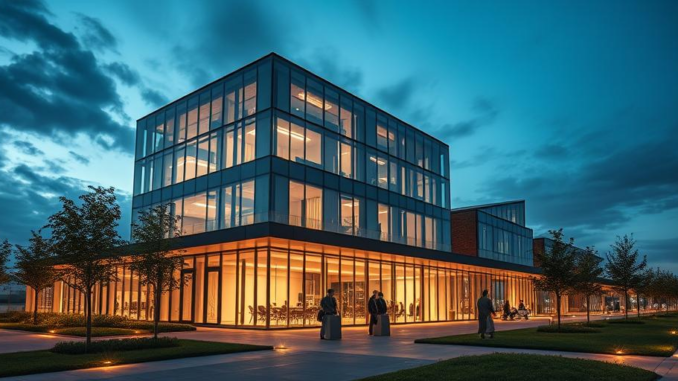
Summary
This article provides a comprehensive guide to improving your BREEAM rating, covering crucial steps from early planning to incorporating innovative technologies. It emphasizes the importance of user well-being, energy efficiency, and choosing the right materials. By following these steps, you can significantly enhance your building’s sustainability and achieve a higher BREEAM rating.
Discover how Focus360 Energy can help with BREEAM certification.
** Main Story**
So, you’re looking to boost your BREEAM rating? Excellent! A high BREEAM score isn’t just a feel-good badge; it’s a solid indicator of sustainable building practices, translates to increased market value, lower operating costs, and a much healthier environment for everyone. Let’s break down the steps you can take to really elevate that score.
Early Engagement and Site Assessment: Get the Ball Rolling
Seriously, one of the smartest things you can do is get a licensed BREEAM assessor and a sustainability consultant on board as early as possible – during the planning phase, ideally. Their expertise is invaluable and it will make your life so much easier. Think of them as your BREEAM navigators.
And then there’s the site assessment. You need a deep understanding of the site’s limitations and potential. What are the constraints? What opportunities are there to enhance its ecological value? For instance, if you’re smack-bang in a city center, you might find it tricky to install loads of renewable energy installations. However, a rural spot may have huge potential for biodiversity improvements. Knowing what you’re up against early doors lets you develop targeted strategies, and it can even earn you extra credits. So, yeah, early engagement is key.
Setting Clear Goals and Choosing the Right Scheme: Know Where You’re Going
Next up: nail down your sustainability objectives. They need to be clear, measurable, and aligned with the specific BREEAM categories that matter to your project. Think of these goals as your project roadmap, they’ll guide every decision along the way. Plus, make sure you’re using the right BREEAM scheme for your building type and project stage. It’s no good trying to fit a square peg in a round hole, is it?
User Well-being and Energy Efficiency: Happy People, Happy Planet
Now, let’s talk about the people who’ll actually use the building. Design with their well-being front and center. Think about things like plenty of natural light, good indoor air quality, and ergonomic spaces. It not only pushes up your BREEAM rating but also creates a building people actually want to be in. It’s a win-win! I remember visiting a building a few years ago where the architects had really focused on natural light and ventilation; the atmosphere was noticeably better, and people were just more productive.
Speaking of wins, energy efficiency is critical in BREEAM assessments. Implement energy-saving measures like efficient HVAC systems, really good insulation, and renewable energy sources, like solar panels. Smart building systems and automation can further optimize energy use. It’s like giving your building a brain that’s constantly thinking about how to save energy.
Sustainable Materials and Lifecycle Analysis: Think Green from Cradle to Grave
We need to talk about materials, specifically, sustainable materials with a lower carbon footprint. And not just about the materials themselves, but think about their entire lifecycle, from sourcing right through to disposal. A thorough lifecycle analysis helps you make informed choices that minimize waste and maximize resource efficiency. You could consider innovative construction techniques, like modular construction, which significantly reduce waste during the building process.
Innovation and Ongoing Improvements: Don’t Be Afraid to Try New Things
Embrace innovation. Seriously, don’t be afraid to explore cutting-edge technologies. These new technologies should enhance energy efficiency, resource conservation, and user well-being. Novel approaches to material selection and waste reduction? Gold dust for your BREEAM rating! Push the envelope and explore solutions beyond standard practices to really maximize those innovation credits. I always think it’s worth taking a risk on these things.
And what happens after the building’s finished? You monitor and evaluate its performance. Continuous improvement ensures long-term sustainability and helps you maintain a high BREEAM rating.
Maximizing Your Score: Advanced Strategies and Technologies
Want to really push things? Think about using Computational Fluid Dynamics (CFD) simulations to analyze your building’s interior behavior, things like air quality and temperature. And transportation – are you close to public transport and amenities? Prioritizing the use of recycled and locally sourced materials helps a lot. And don’t forget about green roofs! These are fantastic. Aim for low or zero-carbon technologies to seriously reduce your building’s environmental impact.
Conclusion: A Sustainable Future Starts with You
So, there you have it. By implementing these strategies, you’re not just building a building; you’re building a sustainable future. A high BREEAM rating demonstrates your commitment to environmental responsibility, enhances your project’s market value, reduces operational costs, and creates a healthier, more productive environment for occupants. It’s a legacy you can be proud of. And hey, future generations will thank you for it. Isn’t that worth striving for?


BREEAM navigators! I love it! Suddenly picturing tiny assessors with maps and compasses guiding buildings to sustainability. I wonder if they offer a frequent flyer program for eco-friendly structures. “Achieve Gold status and unlock premium insulation!”
That’s a fun image! Maybe instead of frequent flyer miles, buildings get ‘green points’ they can redeem for upgrades like solar panels or rainwater harvesting systems. It would be a great incentive to push for even higher sustainability standards!
Editor: FocusNews.Uk
Thank you to our Sponsor Focus 360 Energy